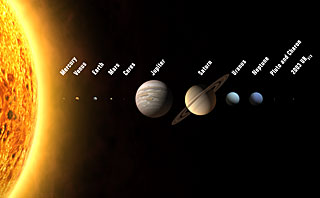New Planets and a Larger Solar System

More planets?
by Chris Frantz
 A view of the new solar system, thanks to The International Astronomical Union/Martin Kornmesser Related Links |
News Flash (August 24, 2006)—
Pluto Demoted! Read All About It Here.
This article was first featured on August 19, 2006. The proposal described has since been rejected. Read about it here.
Voting Soon
The International Astronomical Union (IAU) will be voting on an official definition of the word "planet" at their general assembly on Aug. 24, 2006. Celestial bodies must meet the following two conditions in order to be classified as planets: (1) The object must be in orbit around a star, while not being itself a star, and (2) The body must be massive enough for its own gravity to pull it into a nearly spherical shape, generally with a diameter greater than 497 mi (800 km). The IAU proposes to include the largest asteroid Ceres, Pluto's satellite Charon, and 2003 UB313 (just announced in July 2005 and nicknamed "Xena") as the newest planets in our solar system.
"Classical" Planets
Mercury through Neptune would be described as "classical" planets; Ceres, Pluto, Charon, and 2003 UB313 have a "dwarf" description. A new category of planets, pluton (named, of course, after Pluto), is for planets that take longer than 200 years to complete an orbit around the Sun. These orbits also tend to be eccentric—far from being circular and and also have a greater orbital tilt ("inclination") than those of the classical planets.
Double Planet
Charon would lose its satellite classification and with Pluto would be considered a "double planet." A double planet is two bodies that have their common center of gravity ("barycenter") between them in space and not in the interior of either planet. The barycenter of the Moon and Earth is within the Earth, not in space.
More Planets to Come?
The IAU also has a dozen candidate planets awaiting future inclusion in the solar system. Future denizens of our system could include Sedna, Orcus, Quaoar, Varuna, Ixion—all found beyond Pluto; the asteroids Vesta, Pallas, and Hygiea; and four yet unnamed bodies (2003 EL61, 2005 FY9, 2002 TX300, and 2002 AW197).
- More about The Solar System
